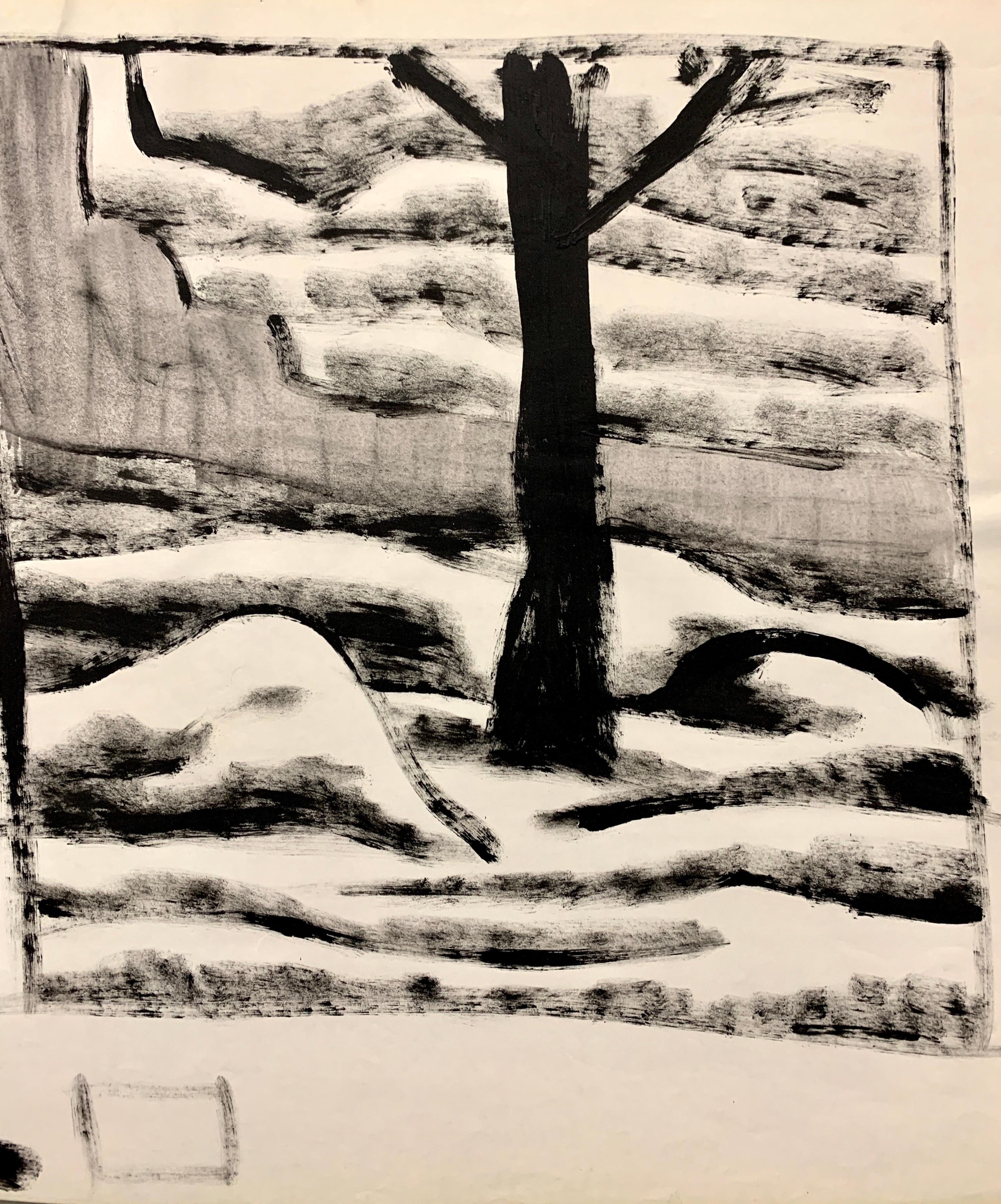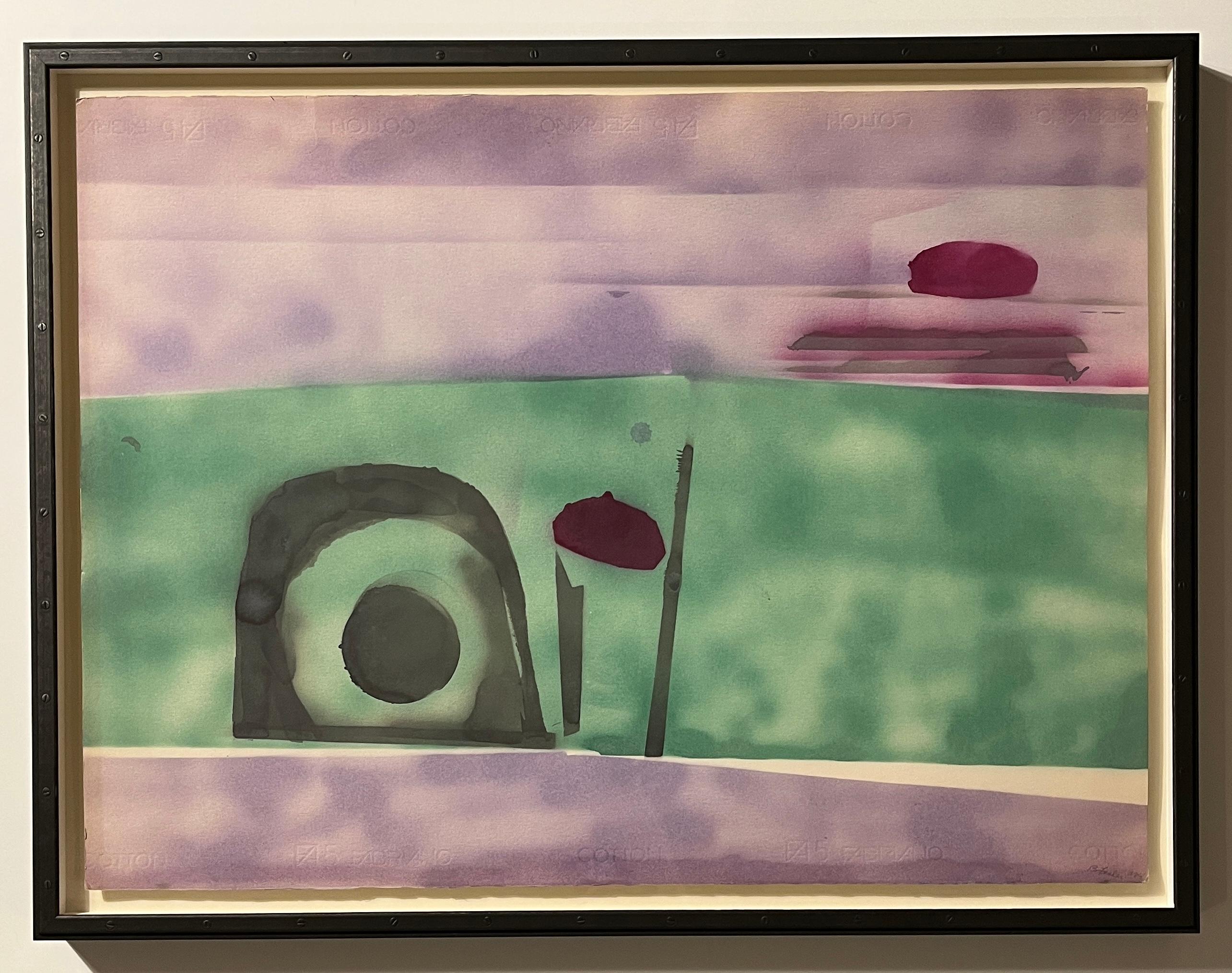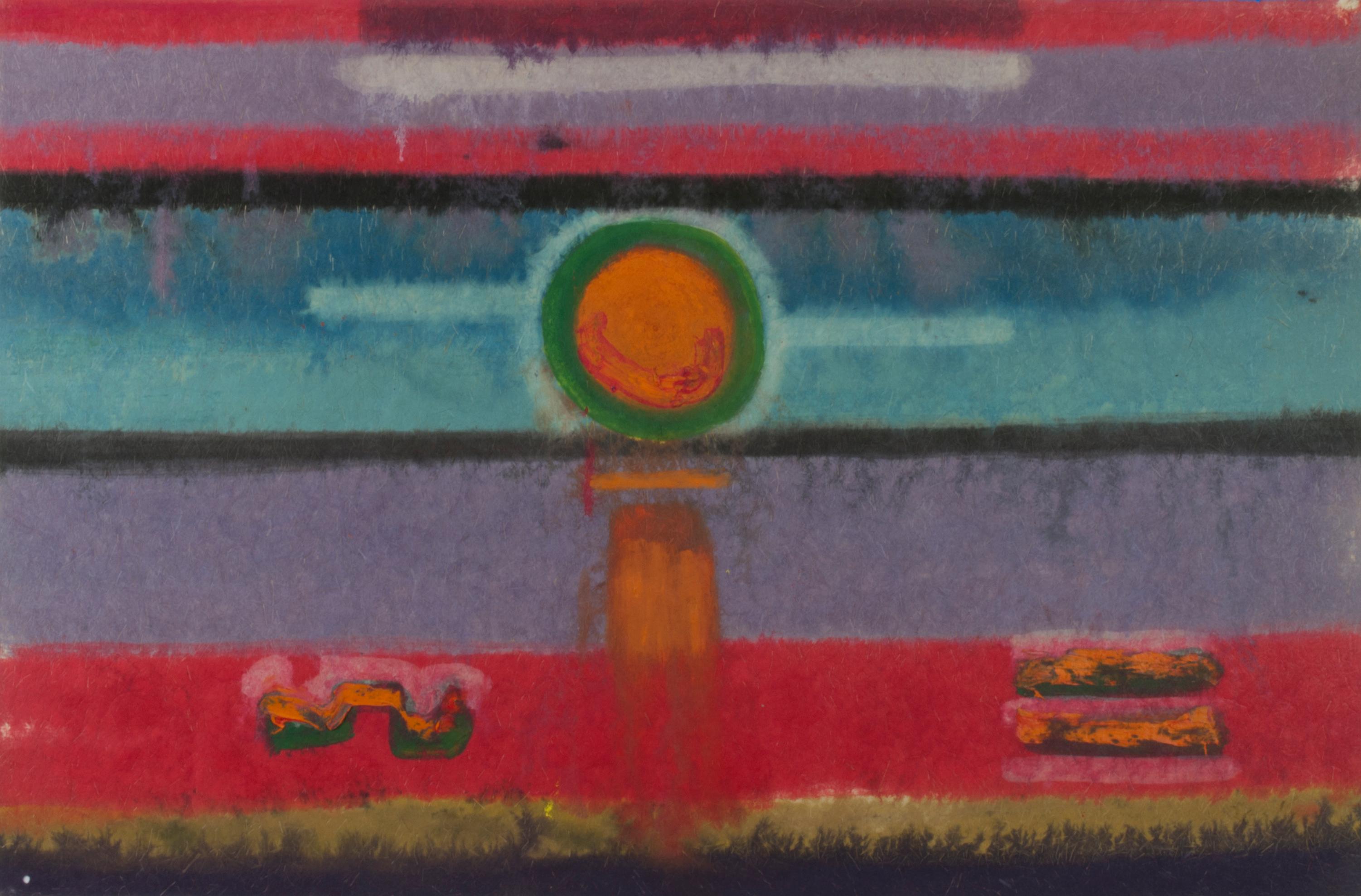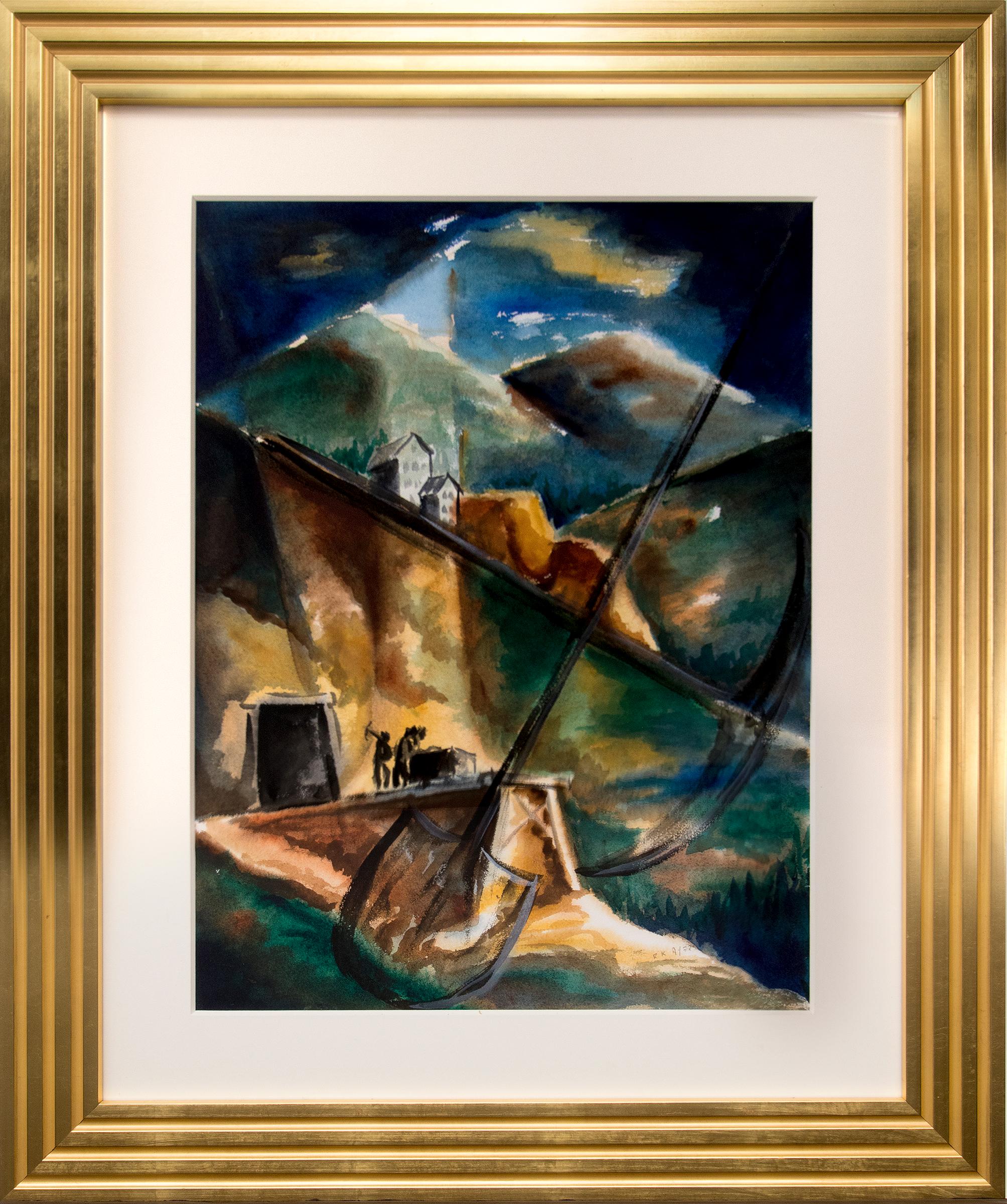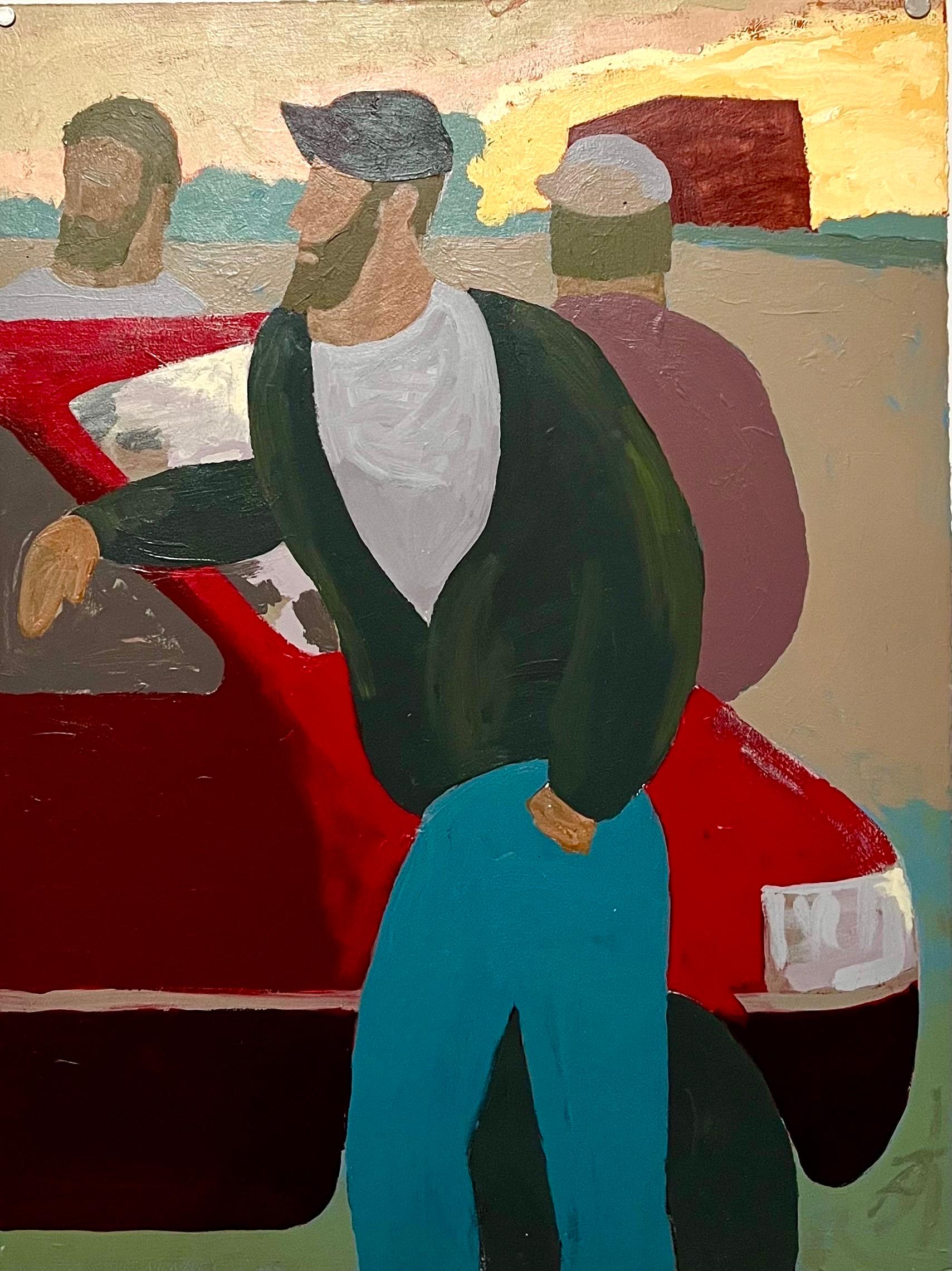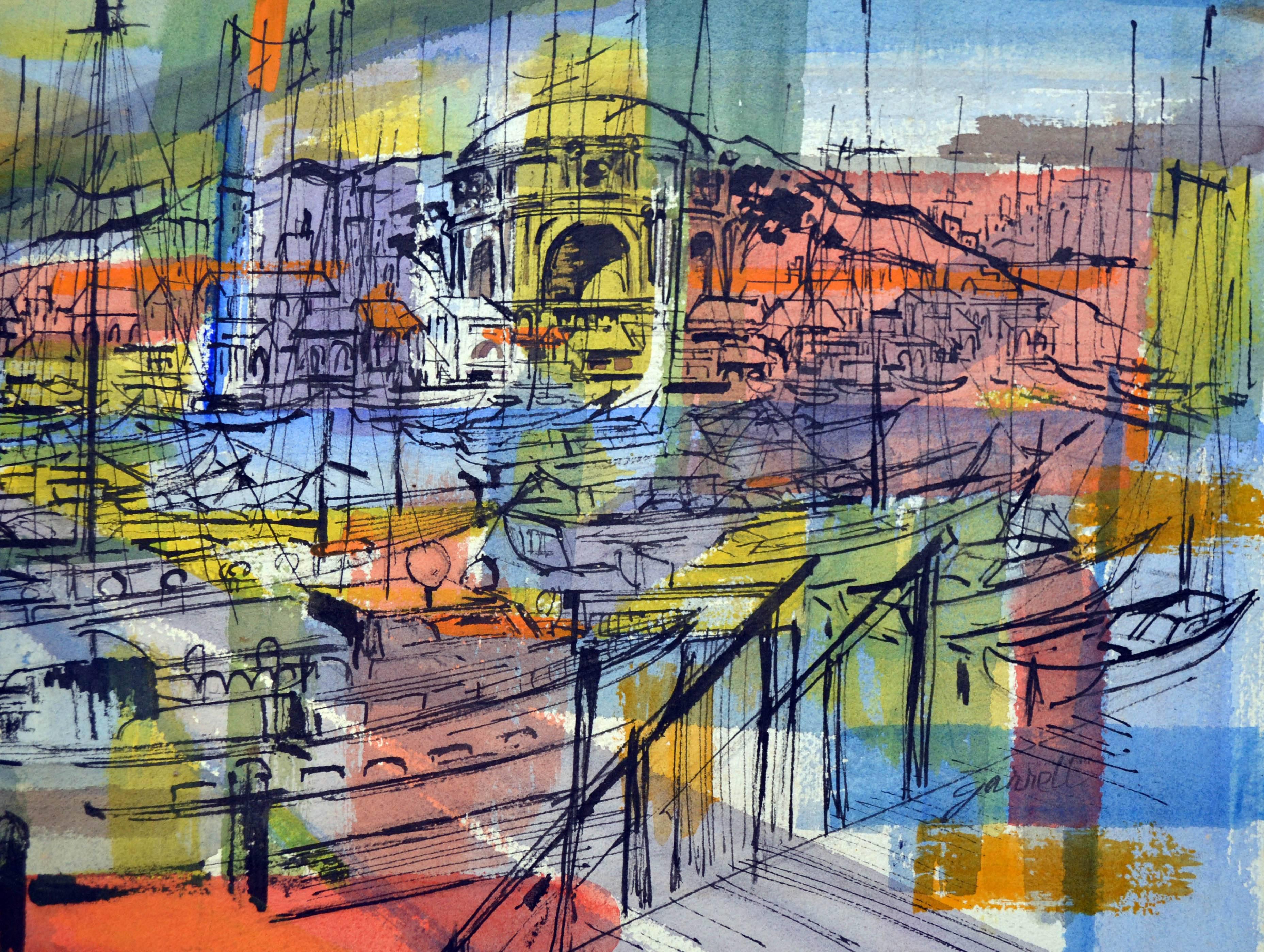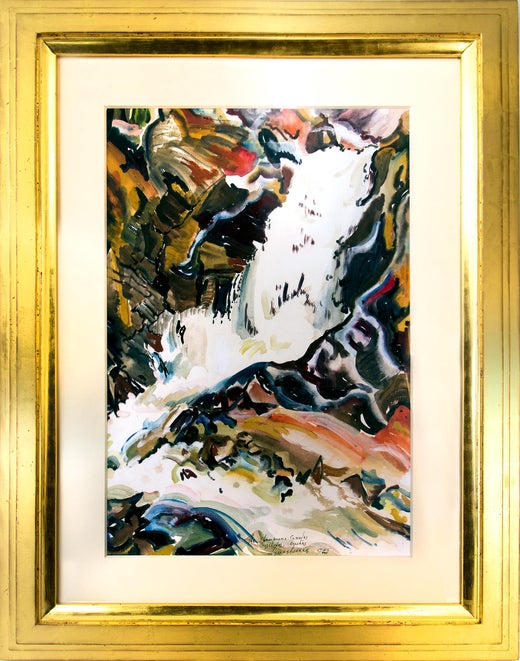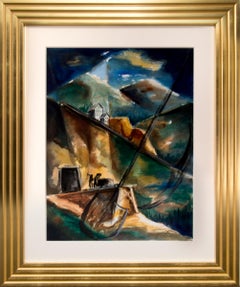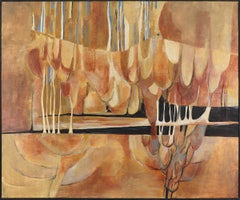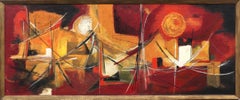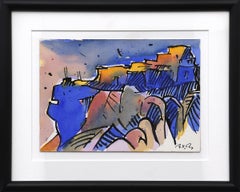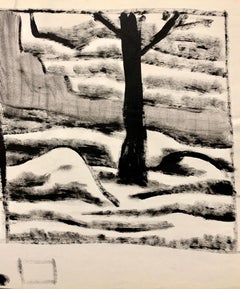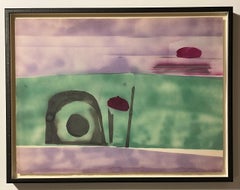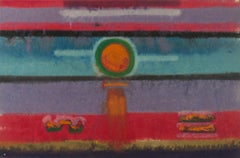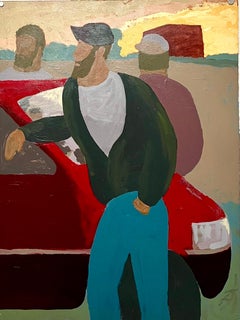Items Similar to Modernist 1945 Abstract Waterfall Watercolor Landscape Painting by Eve Drewelowe
Want more images or videos?
Request additional images or videos from the seller
1 of 14
Eve DreweloweModernist 1945 Abstract Waterfall Watercolor Landscape Painting by Eve Drewelowe1945
1945
About the Item
This striking 1945 abstract landscape watercolor by pioneering modernist artist Eve (Van Ek) Drewelowe, titled "The Champagne Cascades, Crescendos, Crashes," is a bold interpretation of a waterfall in motion. Rendered in an expressive palette of white, yellow, and black, the composition flows with rhythmic energy and fluidity. Drewelowe’s minimalist approach captures the essence of natural movement while embracing abstract forms that hint at the post-war shift in American art.
The work is presented in a custom gold frame, with outer dimensions measuring 43 ¾" H x 33 ¾" W x ½" D. The image size is 29 ¾" H x 19 ¾" W.
Provenance:
Private collection, Denver, Colorado
About the Artist:
Eve Drewelowe (1899–1988) was a groundbreaking American modernist and the first woman to earn a master’s degree in fine arts from the University of Iowa in 1924. Known for her vibrant color palette and a strong connection to the natural world, she created over 1,000 works across a variety of media including watercolor, oil, collage, sculpture, and printmaking.
A longtime resident of Boulder, Colorado, Drewelowe became an influential figure in the development of the regional art scene, helping to establish a distinct artistic identity in the American West. Her work evolved from impressionistic landscapes to abstract, surrealist-inspired compositions infused with energy, emotion, and environmental awareness. Throughout her career, she explored themes of transformation, nature’s power, and the resilience of the human spirit—often through a feminist lens.
Drewelowe’s works have been exhibited nationally and internationally and are held in prestigious collections, including the University of Iowa, University of Colorado, and the Kirkland Museum of Fine & Decorative Art in Denver. A passionate advocate for women in the arts, she also helped fund scholarships supporting female artists, ensuring her legacy extended beyond the canvas.
- Creator:Eve Drewelowe (1899 - 1989, American)
- Creation Year:1945
- Dimensions:Height: 43.75 in (111.13 cm)Width: 33.75 in (85.73 cm)Depth: 0.5 in (1.27 cm)
- Medium:
- Movement & Style:
- Period:
- Framing:Frame IncludedFraming Options Available
- Condition:very good to excellent condition.
- Gallery Location:Denver, CO
- Reference Number:Seller: 258811stDibs: LU27310377202
Eve Drewelowe
From her earliest memory, Eve Drewelowe wanted to be an artist, and she became the first student to receive a masters of fine arts from the University of Iowa. After graduation, she went with her new husband to Boulder, Colorado, where she soon found herself in the role of dean’s wife. Eventually that responsibility and its “chores” proved to be too restrictive. After a health crisis, Drewelowe had a self-described “reincarnation” in which she resolved to make a place for her creativity. Naturally effusive, she yet valued being alone, and her strong feelings for life were expressed in her exuberant paintings. Growing up on an Iowa farm, Drewelowe developed a love for the land from her “environmentalist” father, who died when she was eleven. Subsequently, The Dean of the Graduate School at Iowa served as a father-figure when he facilitated her entry into the graduate program in art. Seemingly skeptical, Carl Seashore secretly wanted the young woman to “establish a first in the history of art training across the nation,” as the artist would later reminisce. Drewelowe graduated in 1924, and she later was a benefactor of what became one of the nation’s leading college art programs. At college, Drewelowe met and married a political science student, Jacob van Ek. Accepting a teaching position at the University of Colorado, van Ek moved to Boulder with his bride, who pursued her interest by helping found the Boulder Artists’ Guild. In 1928-1929, they traveled around the world to twenty-three countries for thirteen months, during which Drewelowe filled seven sketchbooks. With her husband now a dean, she threw herself into remodeling their house, a domestically acceptable creative project. Balancing her art and her duties as a dean’s wife, Drewelowe felt increasing frustration, and her health began to suffer. In the catalogue of a 1988 retrospective, she gave voice to her desire for self-determination: “Housewife! What an odious word! First! Foremost! Always! My waking thought from an embryo was on my need to be an artist!” Traveling to New York for her second solo exhibition in 1940, she stopped at the Mayo Clinic, where she was diagnosed as having a gastric polyp. This experience led to a new dedication to her painting, a complete turnaround in which she called her “reincarnation.” Inspired by the Rocky Mountains, she painted animated landscapes that pulsated with energy -- as if still in motion from generative forces. With a rainbow palette, Drewelowe created visionary scenes by intensifying colors in lively, rippling patterns. ©David Cook Galleries, LLC
About the Seller
5.0
Vetted Professional Seller
Every seller passes strict standards for authenticity and reliability
Established in 1979
1stDibs seller since 2013
287 sales on 1stDibs
Typical response time: 2 hours
- ShippingRetrieving quote...Shipping from: Denver, CO
- Return Policy
Authenticity Guarantee
In the unlikely event there’s an issue with an item’s authenticity, contact us within 1 year for a full refund. DetailsMoney-Back Guarantee
If your item is not as described, is damaged in transit, or does not arrive, contact us within 7 days for a full refund. Details24-Hour Cancellation
You have a 24-hour grace period in which to reconsider your purchase, with no questions asked.Vetted Professional Sellers
Our world-class sellers must adhere to strict standards for service and quality, maintaining the integrity of our listings.Price-Match Guarantee
If you find that a seller listed the same item for a lower price elsewhere, we’ll match it.Trusted Global Delivery
Our best-in-class carrier network provides specialized shipping options worldwide, including custom delivery.More From This Seller
View AllModernist Abstract Landscape Watercolor 'Old Mine and Houses, Cortez Colorado'
By Richard Ayer
Located in Denver, CO
This striking 20th-century modernist watercolor by Richard K. Ayers depicts a captivating scene of an old mine and houses in Cortez, Colorado. The artwork features a rich color palette of blue, green, gold, and brown, capturing the rugged beauty of the landscape with a unique, abstract perspective. Presented in a custom frame with all archival materials, the outer dimensions of the piece measure 36 ½ x 30 ½ x ¾ inches, with an image size of 24 ¾ x 18 ¾ inches.
About the Artist: Richard K. Ayers (1921–2003) was a talented artist who studied at Miami University...
Category
20th Century American Modern Abstract Paintings
Materials
Watercolor
$2,250 Sale Price
40% Off
American Modernist Abstract Autumn Landscape Oil Painting – Trees in Fall Colors
Located in Denver, CO
This mid-20th-century abstract landscape oil painting by American modernist Henriette "Yetti" Stolz beautifully captures a stylized forest scene, featuring trees rendered in rich, earthy tones of gold, brown, orange, and blue. The painting reflects Stolz's modernist approach, blending organic forms with abstract color fields. Signed on the back, this piece is presented in a vintage frame, with outer dimensions measuring 30 ¾ x 36 ¼ inches, and the image size is 30 ¼ x 35 ¾ inches.
Provenance:
Estate of the Artist, Henriette "Yetti" Stolz.
About the Artist:
Henriette "Yetti" Stolz was born in Serbia in 1935 and moved to Denver, Colorado, in the early 1950s after WWII. She studied art at Colorado College in Colorado Springs, where she was exposed to the modernist movements shaping the local art scene. Stolz was influenced by contemporary artists such as Mary Chenoweth...
Category
Mid-20th Century American Modern Abstract Paintings
Materials
Ink, Oil
Large Mid-Century Modern Abstract Cityscape Oil Painting, Red, Black & Gold
Located in Denver, CO
This stunning mid-20th-century oil and spackle painting by Henriette "Yetti" Stolz captures a bold, abstract cityscape with a dramatic bridge and towering buildings. The striking com...
Category
Mid-20th Century American Modern Abstract Paintings
Materials
Oil, Putty
Walpi #4 - Original Semi-Abstract Southwestern Landscape Watercolor Mixed Media
Located in Denver, CO
"Walpi #4" is an original semi-abstract Southwestern landscape by renowned 20th-century artist Bert Van Bork (1928-2014). This captivating watercolor and mixed media painting portrays the dramatic beauty of a Native American Pueblo village nestled on the mesa of First Mesa, Arizona. Van Bork skillfully uses vibrant hues of deep blue, yellow, orange, and pink to convey the cultural richness and natural splendor of the Hopi people. The piece features adobe structures set against the expansive desert sky, merging the artist’s unique style with his deep reverence for Native American heritage.
Presented in a custom white frame with archival materials and UV-protectant glass, the framed artwork measures 8 ½ x 10 ½ x ½ inches, with the image size being 4 ¾ x 7 inches.
Provenance: Estate of Bert Van Bork, Evanston, Illinois
About the Artist:
Bert Van Bork (1928-2014) was a German-born artist, filmmaker, photographer, and writer. Trained under Karl Schmidt-Rottluff in Berlin, he played a significant role in the post-war German art scene before immigrating to the U.S. in 1954. Known for his work as a printmaker and photographer, Van Bork's powerful documentary films earned global recognition, including an Academy Award nomination for EYEWITNESS, the Legacy of Death Camp Art...
Category
21st Century and Contemporary Abstract Landscape Paintings
Materials
Charcoal, Ink, Watercolor
"Mesa Verde", 1980s Original Abstract Landscape Oil Painting, Yellow, Pink, Gold
Located in Denver, CO
This striking original abstract oil painting, titled Mesa Verde, was created by artist Wilma Fiori (1929–2019) on November 17, 1988. The piece is a vibrant...
Category
1980s Abstract Abstract Paintings
Materials
Oil
1960s Mid Century Modern Desert Landscape Acrylic Painting in Rich Earth Tones
Located in Denver, CO
This captivating 1960s abstract painting, titled "Desert Landscape," is a striking original work by acclaimed New Mexico and Colorado artist Ann Sink. The composition beautifully cap...
Category
1960s Abstract Expressionist Abstract Paintings
Materials
Acrylic
You May Also Like
1950s "Mound Street" Mid Century Figurative Painting American Modernist
By Donald Stacy
Located in Arp, TX
Donald Stacy
"Mound Street"
c. 1950s
Gouache paint on paper
24" x 18'" unframed
Unsigned
Came from artist's estate
For sale is a striking black and white painting titled "Mound Stre...
Category
Mid-20th Century American Modern Abstract Paintings
Materials
Paper, Gouache
1950s "Purple Sky Landscape" Mid Century Abstract Landscape Painting
By Donald Stacy
Located in Arp, TX
Bearnice Fisher
"Purple Sky Landscape"
1978
Gouache on paper
30" x 22.5" unframed
Signed and dated lower right in pencil
Bearnice Fisher lived and worked in NYC
Category
Mid-20th Century American Modern Landscape Paintings
Materials
Paper, Gouache
Arctic Light - Orange Sun
By Karl Zerbe
Located in Fairlawn, OH
Arctic Light-Orange Sun
Unsigned
Gouache on Japanese fibrous paper
Series: Tundra Paintings
Exhibited: Karl Zerbe, Gouaches of the Artic
Nordness Gallery, (Madison Avenue, NY) Feb 3 through Feb 23, 1958
Cat. No. 12 (label with work, see photo...
Category
1950s American Modern Abstract Paintings
Materials
Gouache
Large Hudson River Figurative Modernist Landscape Oil Painting Edward Avedisian
By Edward Avedisian
Located in Surfside, FL
Edward Avedisian ( 1936-2007 )
Gouache or oil on paper, 3 guys around a car,
hand signed in paint lower left,
Measures 30"x 22.5"
Edward Avedisian (June 15, 1936, Lowell, Massachusetts – August 17, 2007, Philmont, New York) was an American abstract painter who came into prominence during the 1960s. His work was initially associated with Color field painting and in the late 1960s with Lyrical Abstraction and Abstract Expressionism.
He studied art at the School of the Museum of Fine Arts, Boston. By the late 1950s he moved to New York City. Between 1958 and 1963 Avedisian had six solo shows in New York. In 1958 he initially showed at the Hansa Gallery, then he had three shows at the Tibor de Nagy Gallery and in 1962 and 1963 at the Robert Elkon Gallery. He continued to show at the Robert Elkon Gallery almost every year until 1975.
During the 1960s his work was broadly visible in the contemporary art world. He joined the dynamic art scene in Greenwich Village, frequenting the Cedar Tavern on Tenth Street, associating with the critic Clement Greenberg, and joining a new generation of abstract artists, such as Darby Bannard, Kenneth Noland, Jules Olitski, and Larry Poons.
Avedisian was among the leading figures to emerge in the New York art world during the 1960s. An artist who mixed the hot colors of Pop Art with the cool, more analytical qualities of Color Field painting, he was instrumental in the exploration of new abstract methods to examine the primacy of optical experience.
One of his paintings was appeared on the cover of Artforum, in 1969, his work was included in the 1965 Op Art The Responsive Eye exhibition at the Museum of Modern Art and in four annuals at the Whitney Museum of American Art. His paintings were widely sought after by collectors and acquired by major museums in New York and elsewhere. He has been exhibited in prominent galleries, such as the Anita Shapolsky Gallery and the Berry Campbell Gallery in New York City. Edward Avedisian was known for his brightly colored, boldly composed canvases that combined Minimalism's rigor, Pop art exuberance and the saturated tones of Color Field painting.
Roberta Smith of the NYT writes of Avedesian: "Edward Avedisian helped establish the hotly colored, but emotionally cool, abstract painting that succeeded Abstract Expressionism in the early 1960s. This young luminary harnessed elements of minimalism, pop, and color field painting to create prominent works of epic proportions that energized the New York art scene of the time." In 1996 Avedisian showed his paintings from the 1960s at the Mitchell Algus Gallery, then in SoHo. His last show, dominated by recent landscapes, was in 2003 at the Algus gallery, now in Chelsea.
Selected Exhibitions:
Op Art: The Responsive Eye, at the Museum of Modern Art,
Whitney Museum’s Young America 1965
Expo 67, held in Montreal, Canada.
Six Painters (along with Darby Bannard, Dan Christensen, Ron Davis...
Category
20th Century American Modern Landscape Paintings
Materials
Oil, Gouache, Archival Paper
Mid Century Palace of Fine Arts, San Francisco Landscape
Located in Soquel, CA
Palace of Fine Arts, San Francisco by Garrett Price (American, 1896-1979). Signed "Garrett" lower right. Unframed. Image size, 11.75"H x 15.25"W. G...
Category
1950s American Modern Abstract Paintings
Materials
Paper, Watercolor
$760 Sale Price
20% Off
Christopher Street (abstract Greenwich Village cityscape)
By De Hirsch Margules
Located in Wilton Manors, FL
De Hirsh Margules (1899-1965). Christopher Street, 1939. Watercolor on Arches wove paper. Signed and dated in pencil by artist lower margin. Sheet measures 15.5 x 20 inches. Window in matting measures 15 x 19 inches. Framed measurement: 23 x 30 inched. Bears fragment of original label affixed on verso. Incredibly vibrant and saturated color with no fading or toning of sheet.
Provenance: Babcock Galleries, NYC
Exhibited: The American Federation of Arts Traveling Exhibition.
From the facade of The Waverly at Christopher is depicted One Christopher Street, the 16-story Art Deco residential building erected in 1931. It is not a casual coincidence that the structure appears in this cityscape: 1 Christopher Street is the subject. The original intention of this project was to transform the neighborhood, bring a bit of affluence and make a bid to rival the Upper West Side. Margules, a sensitive aesthete, understood how a massive piece of architecture such as One changes a neighborhood. Sound, scale and focal points are forever altered. A pedestrian's sense of depth and distance becomes pronounced. All of these factors contribute to the intent behind this image. Tall buildings disrupt the human scale, change the skyline and carve up space. In this piece, negative space conforms to the man-made geometries. Clouds become gems fixed in settings.
De Hirsh Margules (1899–1965) was a Romanian-American "abstract realist" painter who crossed paths with many major American artistic and intellectual figures of the first half of the 20th century. Elaine de Kooning said that he was "[w]idely recognized as one of the most gifted and erudite watercolorists in the country". The New York Times critic Howard Devree stated in 1938 that "Margules uses color in a breath-taking manner. A keen observer, he eliminates scrupulously without distortion of his material." Devree later called Margules "one of our most daring experimentalists in the medium"
Margules was also a well-known participant in the bohemian culture of New York City's Greenwich Village, where he was widely known as the "Baron" of Greenwich Village.[1] The New York Times described him as "one of Greenwich Village's best-known personalities" and "one of the best known and most buoyant characters about Greenwich Village.
Early Life
De Hirsh Margules was born in 1899 in the Romanian city of Iași (also known as Iasse, Jassy, or Jasse). When Margules was 10 weeks old, his family immigrated to New York City. Both of his parents were active in the Yiddish theater, His father was Yekutiel "Edward" Margules, a "renowned Jewish actor-impresario and founder of the Yiddish stage." Margules' mother, Rosa, thirty-nine years younger than his father, was an actress in the Yiddish theater and later in vaudeville. Although Margules appeared as a child actor with the Adler Family[11] and Bertha Kalich, his sister, Annette Margules, somewhat dubiously continued in family theater and vaudeville tradition, creating the blackface role of the lightly-clad Tondelayo (a part later played on film Hedy Lamarr) in Earl Carroll's 1924 Broadway exoticist hit, White Cargo. Annette herself faced stereotyping as an exotic flower: writing about her publicist Charles Bouchert stated that "Romania produces a stormy, temperamental type of woman---a type admirably fitted to portray emotion." His brother Samuel became a noted magician who appeared under the name "Rami-Sami." Samuel later became a lawyer, representing magician Horace Goldin, among others. A family portrait including a young De Hirsh, a portrait of Rosa and Annette together, and individual photos of Rosa and Edward can be found on the Museum of the City of New York website.
At around age 9 or 10, Margules took art classes with the Boys Club on East Tenth Street, and his first taste of exhibition was at a student art show presented by the club. By age 11, he had won a city-wide prize (a box camera) at a children's art show presented by the department store Wanamakers.
As a young teenager, Margules was already displaying a characteristic kindness and loyalty. Upon hearing that two friends (one of them was author Alexander King), were in trouble for breaking a school microscope, the nearly broke Margules gave them five dollars to repair the microscope . Margules had to approach a wealthy man that Margules had once saved on the subway from a heart attack. Margules didn't reveal the source of the five dollars to King until twenty-five years later.
In his late teens, Margules studied for a couple of months in Pittsburgh with Edwin Randby, a follower of Western painter Frederic Remington. Thereafter he pursued a two-year course of studies in architecture, design and decoration at the New York Evening School of Art and Design, while working as a clerk during the day at Stern's Department Store. He was encouraged in these artistic pursuits by his neighbor, the painter Benno Greenstein (who later went by the name of Benjamin Benno).
Artistic career
In 1922, Margules began work as a police reporter for the City News Association of New York .Margules then considered himself something of an expert on art, and the painter Myron Lechay is said to have responded to some unsolicited analysis of his work with the remark "Since you seem to know so much about it, why don't you paint yourself?" This led to study with Lechay and a flurry of painting.
Margules' first show was in 1922 at Jane Heap's Little Review Gallery. Thereafter Margules began to participate in shows with a group including Stuart Davis, Jan Matulka, Buckminster Fuller (exhibiting depictions of his "Dymaxion house") in a gallery run by art-lover and restaurateur Romany Marie on the floor above her cafe.
Jane Heap, left, with Mina Loy and Ezra Pound
During the 1920s, Margules traveled outside of the country a number of times. In 1922, with the intent of reaching Bali, he took a job as a "'wiper on a tramp steamer where [he] played nursemaid to the engine." He reached Rotterdam before he turned back. He would return to Rotterdam shortly thereafter.
In 1927, Margules took a lengthy leave of absence from his day job as a police reporter in order to travel to Paris, where he "set up a studio in Montmartre's Place du Tertre, on the top floor of an almost deserted hotel, a shabby establishment, lacking both heat and running water." He studied at the Louvre and traveled to paint landscapes in provincial France and North Africa.
Margules also joined the "Noctambulist" movement and experimented with painting and showing his artwork in low light.Jonathan Cott wrote that:
the painter De Hirsch Margulies sat on the quays of the Seine and painted pictures in the dark. In fact, the first exhibition of these paintings, which could be seen only in a darkened room, took place in [ Walter Lowenfels'] Paris apartment.
Elaine de Kooning remarked that studying the works of the Noctambulists confirmed Margules' "direction toward the use of primary colors for perverse effects of heavy shadow."
It was also in Paris that Margules initially conceived his idea of "Time Painting", where a painting is divided into sectors, each representing a different time of day, with color choices meant to evoke that time of day.
In Paris, his social circle included Lowenfels, photographer Berenice Abbott, publisher Jane Heap, composer George Anthiel, sculptor Thelma Wood, painter André Favory, writer Norman Douglas, writer and editor George Davis, composer and writer Max Ewing, and writer Michael Fraenkel.
Upon his return to New York in 1929, Margules attended an exhibition of John Marin's paintings.
While at the exhibition, he "launched into an eloquent explanation of Marin to two nearby women", and was overheard by an impressed Alfred Stieglitz. The famous photographer and art promoter invited Margules to dine with his wife, the artist Georgia O'Keeffe, and his assistant, painter Emil Zoler. Stieglitz thereafter became a friend and mentor to Margules, becoming for him "what Socrates was to his friends."
Alfred Stieglitz
Stieglitz introduced Margules to John Marin, who quickly became the most important painterly influence upon Margules. Elaine de Kooning later noted that Margules was "indebted to Marin and through Marin to Cézanne for his initial conceptual approach - for his constructions of scenes with no negative elements, for skies that loom with the impact of mountains." Margules himself said that Marin was his "father and ... academy." The admiration was by no means unreciprocated: Marin said that Margules was "an art lover with abounding faith and sincerity, with much intelligence and quick seeing." Stieglitz also introduced Margules to many other artistic and intellectual figures in New York.
With the encouragement of Alfred Stieglitz, Margules in 1936 opened a two-room gallery at 43 West 8th Street called "Another Place." Over the following two years there were fourteen solo exhibitions by Margules and others, and the gallery was well-respected by the press. It was in this gallery that the painter James Lechay, Myron's brother, exhibited his first painting.
In 1936, Margules first saw recognition by major art museums when both the Museum of Modern Art and the Museum of Fine Arts, Boston purchased his works.
In 1942, Margules gave up working as a police reporter, and apparently dedicated himself thereafter solely to an artistic vocation.
"The Baron of Greenwich Village"[edit]
Margules made his mark not only as an artist, but also as an outsized personality known throughout Greenwich Village and beyond.
To local residents, Margules was known as the "Baron", after Baron Maurice de Hirsch, a prominent German Jewish philanthropist. Margules was easily recognizable by the beret he routinely wore over his long hair. Writer Charles Norman said that he "dressed with a flair for sloppiness."
He was said to "know everybody" in Greenwich Village, to the extent that when the novelist and poet Maxwell Bodenheim was murdered, Margules was the first one the police sought to identify the body. Margules' letters show him interacting with art world figures such as Sacha Kolin, John Marin and Alfred Stieglitz, as well as with prominent figures outside the art world such as polymath Buckminster Fuller and writer Henry Miller.
Most of his friends and acquaintances found Margules a generous and voluble man, given to broadly emotionally expressive gestures and acts of kindness and loyalty. In 1929, he exhibited an example of this loyalty and fellow-feeling when he appeared in court to fight what the wrongful commitment of his friend, writer and sculptor Alfred Dreyfuss, who appeared to have been a victim of an illicit attempt to block an inheritance.
The Greenwich Village chronicler Charles Norman described the bone-crushing hugs that Margules would routinely bestow on his friends and acquaintances, and speaks of the "persuasive theatricality" that Margules seemed to have inherited from his actor parents. Norman also wrote about Margules' routine acts of kindness, taking in homeless artists, constantly feeding his friends and providing the salvatory loan where needed. Norman also notes that Margules was blessed with a loud and good voice, and was apt to sing an operatic air without provocation.
The writer and television personality Alexander King said
I think the outstanding characteristics of my friend's personality are affirmation, emphasis, and overemphasis. He chooses to express himself predominantly in superlatives and the gestures which accompany his utterances are sometimes dangerous to life and limb. Of the bystanders, I mean.
King also spoke with affectionate amusement about Margules' pride in his cooking, speaking of how "if he should ever invite you to dinner, he may serve you a hamburger with onions, in his kitchen-living room, with such an air of gastronomic protocol, such mysterious hints and ogliing innuendoes, as if César Ritz and Brillat-Savarin had sneaked out, only a moment before, with his secret recipe in their pockets."
Margules was such a memorable New York personality that comic book writer Alvin Schwartz imagined him at the Sixth Avenue Cafeteria in a risible yet poignant debate with Clark Kent about whether Superman had the ability to stop Hitler.
Margules' entrenchment in the Greenwich Village milieu can be seen in a photograph from Fred McDarrah's "Beat Generation Album" of a January 13, 1961 writers' and poets' meeting to discuss "The Funeral of the Beat Generation", in Robert Cordier [fr]'s railroad flat at 85 Christopher Street. Among the people in the same photograph are Shel Silverstein...
Category
1930s American Modern Abstract Paintings
Materials
Watercolor, Rag Paper
$6,000 Sale Price
20% Off
Recently Viewed
View AllMore Ways To Browse
Waterfall Sculpture
Eve Sculpture
Landscape Painting Waterfalls American
Andrew Wyeth Framed
Oil Painting Gay
Tower Bridge Painting
Dublin 8
Flower Tower
1970s Seascape Oil Painting
Impressionist Food Painting
Jim Love
Modernist Cityscape Painting
Oil Paintings Mississippi
Painting Ancient Ruins
Westminster School
Antique Oil Painting Sunset
Carmel Coast Art
Cliff House
